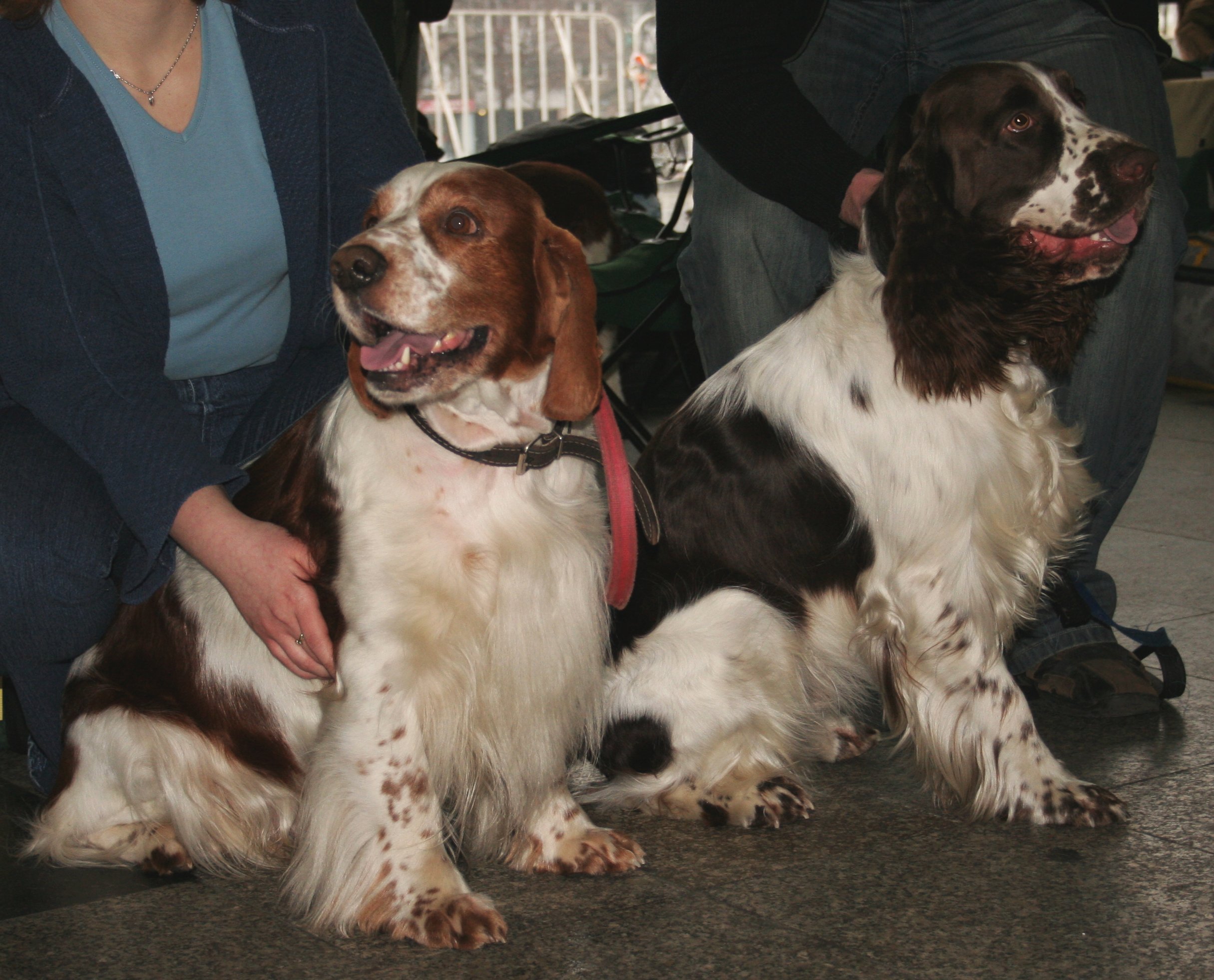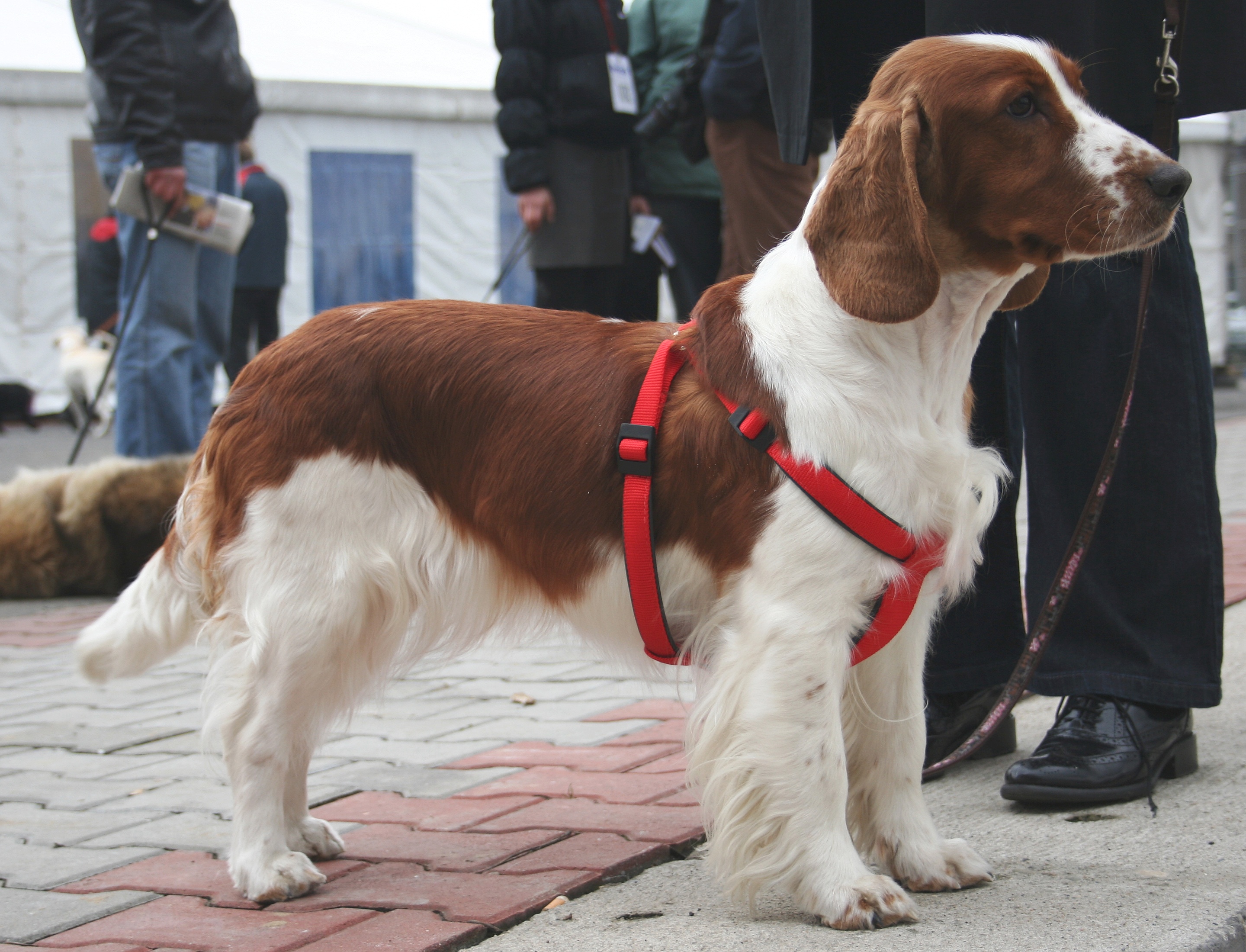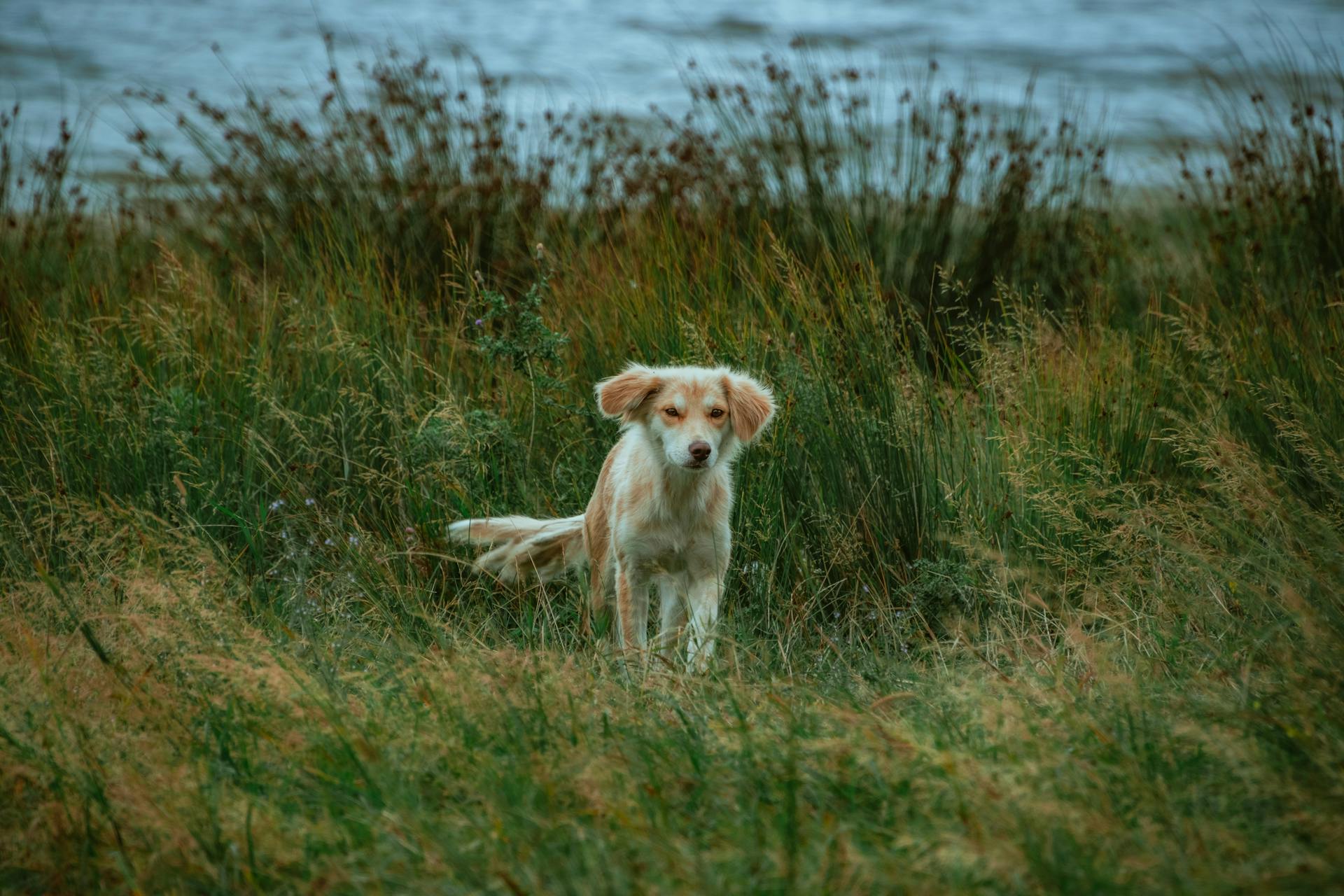
Welsh Springer Spaniels are a popular breed, and for good reason - they're intelligent, energetic, and loving companions.
Their high energy levels require regular exercise, with breeders recommending at least 30 minutes of physical activity per day.
Breeders also stress the importance of socialization from an early age, as Welsh Springer Spaniels can be wary of strangers if not properly introduced.
With proper care and attention, Welsh Springer Spaniels can thrive in a variety of living situations, from apartments to homes with large yards.
Quick Facts
The Welsh Springer Spaniel is a wonderful breed, and if you're considering bringing one home, here are some quick facts to get you started.
Origin: This breed hails from Wales, a beautiful country in the UK.
Male Welsh Springer Spaniels typically stand between 18-19 inches tall at the shoulder, weighing in at 40-45 pounds, while females are slightly smaller, standing at 17-18 inches tall and weighing 35-40 pounds.
The breed group is Sporting, which means they were originally bred for hunting and retrieving game.
With an average lifespan of 12-15 years, Welsh Springer Spaniels can be a long-term companion for you and your family.
Their beautiful coat is long and silky, and comes in a stunning red and white color.
Welsh Springer Spaniels are known for their friendly, outgoing, affectionate, and playful personalities.
If you're considering bringing a Welsh Springer Spaniel home, be prepared for regular exercise – they require a lot of physical activity to stay happy and healthy.
Early and consistent training is also a must, as this breed can be strong-willed at times.
Unfortunately, Welsh Springer Spaniels are prone to some health issues, including hip dysplasia, elbow dysplasia, and eye problems, so be sure to work with a reputable breeder who prioritizes health testing and responsible breeding practices.
Here's a quick summary of the breed's physical characteristics:
- Male: 18-19 inches (46-48 cm) tall at the shoulder, 40-45 pounds (18-20 kg)
- Female: 17-18 inches (43-46 cm) tall at the shoulder, 35-40 pounds (16-18 kg)
Health and Care
Welsh Springer Spaniels are generally healthy, but like all breeds, they're prone to certain health conditions. Hip dysplasia is a common issue, where the thighbone doesn't fit snugly into the hip joint, causing pain and lameness in some dogs.
Check this out: Bernese Mountain Dog Hip Dysplasia
Hip dysplasia can be treated with medication, physical therapy, or surgery, depending on the severity of the case. Responsible breeders test their stock to ensure they don't pass the condition on to their puppies.
Some Welsh Springers are also prone to entropion, a condition where the lower eyelid folds inward, causing chronic irritation of the eye. Surgery can correct this issue.
To keep your Welsh Springer Spaniel happy and healthy, regular exercise and training are crucial. They need mental and physical stimulation through daily exercise and training, and a weekly brushing and nail trim are all that's necessary for their moderate grooming needs.
Here are some common health issues to look out for:
- Hip and Elbow Dysplasia: These conditions occur when the joints form abnormally, leading to pain and mobility issues.
- Autoimmune Thyroiditis: This condition causes the immune system to attack the thyroid gland, diminishing its effectiveness.
- Glaucoma: This condition causes pressure to build up in the eye, eventually leading to blindness if left untreated.
- Ear Infections: With their floppy ears and love of the outdoors, Welsh Springers are prone to ear infections, which can be treated with topical ear drops and antibiotics.
Health Needs
Welsh Springer Spaniels are generally healthy dogs, but like all breeds, they can be prone to certain health issues.
Hip dysplasia is a common condition in Welsh Springers, where the thighbone doesn't fit snugly into the hip joint, leading to arthritis and mobility issues. Responsible breeders test their stock for hip dysplasia and will not breed dogs with the condition.

Epilepsy is another health issue that can affect Welsh Springer Spaniels, causing seizures that can be treated with medication. There is no cure for epilepsy, but with the right treatment, dogs can live happy and healthy lives.
Ear infections are also common in Welsh Springers, particularly in dogs that spend a lot of time outdoors. Symptoms include head shaking, redness of the ear canal, scratching, and a yeasty odor. Topical ear drops and antibiotics can treat ear infections, and weekly ear cleanings can help prevent them from returning.
Glaucoma is a serious eye condition that can cause blindness if left untreated. It's caused by fluid buildup in the eye, and treatment may include eye drops, medication, or surgery. Responsible breeders are taking measures to reduce the occurrence of glaucoma in their breeding stock.
Autoimmune thyroiditis is a genetic condition that can cause the immune system to attack the thyroid gland, diminishing its effectiveness. It can be treated with daily medication and routine blood work. Responsible breeders screen their stock for this condition to reduce the risk of puppies developing it.
Here's a summary of the health issues that can affect Welsh Springer Spaniels:
Diet and Nutrition
Welsh Springers do very well on commercial dog food, provided it's complete, balanced, and made of high-quality ingredients.
To fuel their high energy levels, athletic dogs like the Welsh Springer need more protein in their diet.
Feed your Welsh springer spaniel high-quality dog food twice per day.
You'll need to select the right food based on your pet's age, weight, and activity level, as their nutritional needs will change over time.
Consult with your vet to determine a healthy meal plan and portion sizes based on your dog's age, weight, and activity level.
Monitor portions and treats closely, as food-motivated dogs like the Welsh Springer are likely to gain weight or become obese otherwise.
Those tiny nibbles during training count toward their daily caloric intake, so be mindful of the treats you give them.
For your interest: How Much Exercise Do Labrador Retrievers Need
Care
Welsh Springer Spaniels can thrive in both city apartments and country homes, as long as they get proper exercise.
They're energetic dogs that need a lot of physical activity to stay healthy and happy, so a daily routine that includes exercise and training is essential.

To keep them from becoming bored and lazy, training sessions should be short and positive, rather than repetitive and boring.
Their moderate grooming needs are a breeze, thanks to their weatherproof coat, which requires only a weekly brushing and nail trim, plus an occasional bath.
As loving family dogs, they require significant exercise and training to be well-mannered companions, so be prepared to put in the effort to keep them happy and healthy.
Their long and silky coats can be prone to tangles, so regular grooming is necessary to prevent matting and keep them looking their best.
For another approach, see: Why Are Labradors so Popular
Training and Behavior
Welsh Springer Spaniels respond exceptionally well to training, particularly when using positive reinforcement methods like treats, praise, and playtime with fun toys. At least two 10-minute sessions every day can promote good behavior.
Their origin as a hunting dog means they're naturally active and attentive, making them likely to stay focused during training sessions. Offering them something yummy as a reward helps keep their attention.
Recall training is especially important for this breed, as they have a strong prey drive and may give chase if a furry little critter crosses their path. Without proper recall training, you have only one option left: get your running shoes on and chase after them!
Welsh Springer Spaniels tend to be shy around strangers, so socialization at a young age is crucial. Contact a local certified trainer who's had experience with the breed to help you get started.
Basic obedience lessons should begin when these puppies are about eight weeks old. Since they have plenty of energy and enjoy pleasing their owners, training can be a fun process for both owner and dog.
Welsh Springer Spaniels are known for alert barking, so rewarding good behavior when they quiet down and direct their attention away from barking can be helpful. Consistent training for a reliable recall is also essential, as they retain their hunting instincts and should not be allowed off-leash outside of a fence.
Early socialization is key to helping your Welsh Springer Spaniel become comfortable with different people. With a friendly nature, they'll likely welcome strangers once they're comfortable.
Their gentle temperament makes them great companions to respectful children, but working on training to stop jumping and keep all four paws on the floor is a great way to prevent young children from being knocked over.
On a similar theme: When Is the Best Time to Mate a Female Dog
Welsh Springer Spaniel
The Welsh Springer Spaniel is a breed with a rich history dating back to the 18th century in Wales, where they were prized for their enthusiastic hunting skills.
They were bred to spring upwards, pushing birds higher to be trapped in nets, and have great scenting abilities, making them well-suited for this task. Their webbed feet also make them strong swimmers that can retrieve birds from the water.
In the 19th century, the English Springer Spaniel overtook the Welsh breed in popularity, but the Welsh Springer Spaniel was formally recognized as a separate breed by the Kennel Club in the UK in 1902.
History of the Welsh Springer Spaniel
The Welsh Springer Spaniel has a rich history that spans centuries. They originated in Wales and were developed to flush out game before the use of guns.
Their name "Welsh Springer Spaniel" is a direct result of their ability to spring upon prey once it's down for the count. These intelligent dogs were a favorite among hunters and royalty in the olden days.
The breed was first recognized by the American Kennel Club in 1906, but it took time for their popularity to grow. In the late 19th century, more Welsh Springer Spaniels appeared in shows, and their popularity began to rise.
Despite their popularity, the breed's numbers dropped drastically after World War II, and it was thought that few, if any, remained in the United States. However, passionate enthusiasts were able to revive the breed.
The breed's original purpose was to flush out game and retrieve it, making them excellent companions for hunters. They were also prized for their temperate, affectionate demeanor, which made them excellent additions to families.
Welsh Springer Spaniels are a distinct breed from their cousins, the English Springer Spaniels, and can be easily distinguished by their flowing red and white spotted coat. They are also known for being more reserved than English Springers.
The breed's popularity has increased over the years, but they are still relatively rare compared to their English cousins.
Appearance
The Welsh Springer Spaniel is a stunning breed, and their appearance is one of their most striking features. Their soft red and white coat is a beautiful sight to behold.
Their ears are a notable feature - they're floppy, medium-sized, and lightly feathered. This adds to their adorable and endearing nature.
Their eyes are a lovely medium to dark brown and oval in shape, giving them a soft and gentle expression. It's hard not to fall in love with their sweet gaze.
Their nose is typically black or brown, adding to their charming features. It's a small detail, but it makes a big difference in their overall appearance.
Their coat is soft and straight, with a medium length that's perfect for everyday wear. It's also moderately feathered on their hind legs, chest, and underside, giving them a lovely, flowing look.
Their coat color is a beautiful red and white combination, with some of the white areas flecked with red ticking. It's a unique and eye-catching pattern that sets them apart from other breeds.
Here are the key features of the Welsh Springer Spaniel's appearance:
- Ears: Floppy, medium-sized, and lightly feathered
- Eyes: Medium to dark brown and oval in shape
- Nose: Typically black or brown
- Coat: Soft, straight, and medium length with moderate feathering
- Coat Color: Red and white with red ticking on white areas
Characteristics of the
The Welsh Springer Spaniel is a breed that's all about being with people. They're known for being hard-working, energetic, enthusiastic, and affectionate.
Their people-orientated nature makes them a great choice for families with children, as they welcome strangers as new friends. They're also generally very friendly with other pets.
One thing to keep in mind is that they don't do well on their own, so if you have a job that requires you to be away from home for long periods, this might not be the best breed for you. They're true "velcro dogs" that form strong bonds with their families.
Here are some key characteristics of the Welsh Springer Spaniel:
They're a high-energy breed that requires regular exercise, so if you're an active person who loves the outdoors, they might be a great match for you.
Size
Welsh Springer Spaniels typically stand between 17 and 19 inches tall at the shoulder.
Their weight range is significant, with males usually weighing between 40 to 55 pounds and females weighing between 35 to 50 pounds.
Environment

Welsh Springer Spaniels love to run, so a single-family home with a large yard would be ideal.
They need at least an hour or two of exercise every day. This is non-negotiable, as they can get bored and sullen if they don't get enough physical activity.
They're adaptable to apartment living, but only if their owner is committed to taking them to the park and letting them run.
Welsh Springer Spaniels thrive in family settings and love to be with their owners indoors and out. They're an awesome choice if you've got kids in the household.
They also adapt well to other pets, especially if they're introduced while your Welsh Springer Spaniel puppy is still young.
Welsh Springer Spaniels can be cautious around people they don't know, which may make them a poor choice for homes with a lot of guests or frequent travelers.
You might enjoy: How Fast Is a German Shorthaired Pointer
Frequently Asked Questions
How much does a Welsh Springer Spaniel cost?
A Welsh Springer Spaniel puppy typically costs between $1,800 to $2,000, which may include health and temperament screenings, pedigree papers, and more.
How rare are Welsh springer spaniels?
Welsh Springer Spaniels are a relatively rare breed, with only around 300 puppies registered with the American Kennel Club each year. This limited registration makes them a unique and sought-after companion.
Featured Images: pexels.com


